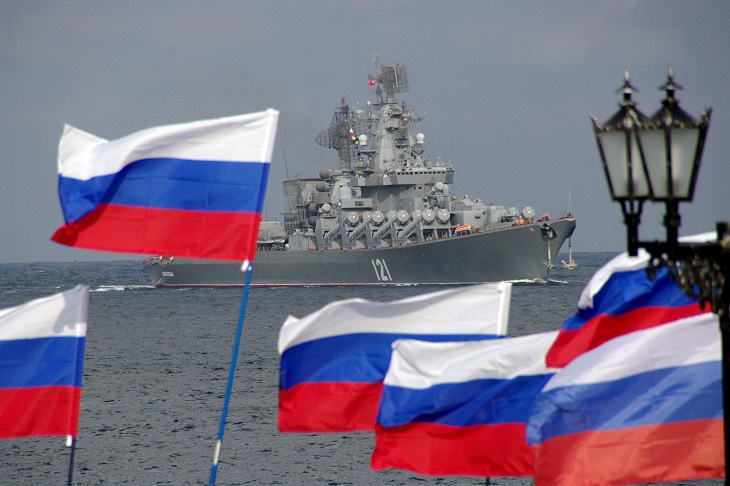It’s early days yet, but the sinking of the Russian cruiser Moskva in the Black Sea, apparently by Ukrainian missiles, looks like being the most significant sinking of a warship in combat since the loss of the ARA General Belgrano, 40 years ago in the Falklands War.
As this is being written, the first reports of the Black Sea action are still emerging, but it appears two shore-based anti-ship missiles aided by drone distractions managed to hit the Russian vessel, causing serious damage. Fires broke out, and unable to be stopped, later caused the ship to capsize and sink. Hundreds of sailors may have died.
The questions raised will be significant.
Query one will be how such missiles got past the ship’s defences. It seems to be the case that the Russian vessel – the flagship of their Black Sea navy, so a serious blow to their morale – was cruising for much of the present two-month-long conflict within range of such weapons for weeks. If so that points to several serious Russian errors. For example, why did they not know such anti-ship missiles – apparently a 170 mile range (270 kilometre) Neptune, derived from the Soviet-designed Kh-35 – were deployed? Their intelligence apparatus may have some answers to provide there. Then again, presumably the Neptune presence was known and discounted.
If that is the case then it would appear the Russians were badly-educated or foolhardy. In the Falklands war HMS Glamorgan was hit by a shore-based anti-ship Exocet missile. Naval officers are trained in military history. ‘Those who fail to learn the lessons of history are condemned to repeat them’, to repeat a much-used maxim of writer and philosopher George Santayana, but used more famously by Winston Churchill. Warships in combat orientate themselves to the threat, working out which direction threats are most likely to appear from, and prepare their defences accordingly.
Moskva was armed with anti-missiles defences, including 64 vertical-launch anti-air missiles, but according to reports she was ‘attacked’ by Turkish-made drones as well. Simulating missiles or aircraft would likely overwhelm or confuse the cruiser’s electronic defences. Nevertheless, she should have had her conventional guns, as well as heavy machine guns, turned on any incoming missile. To be hit by one is unfortunate; to be hit by two looks like a failure to be alert to the danger and an inability to respond. Human error or system failure – the result is the same.
A major combat vessel such as a cruiser would usually be protected by a ‘picket vessel’, a capable smaller warship positioned up-threat. This would have been necessarily an anti-air specialist – the Ukrainians are said to have no submarines as they don’t have a navy – so a radar-equipped ship heavily armed with anti-missile missiles; as well as the usual Close-In Weapons System, which fire enormous quantities of rounds at the target. The Moskva had those too; six in fact, as well as a multi-purpose 130mm gun. However it appears there was no picket ship positioned, or maybe the counter-threat measures were not working.
Of course, the Russians may not have known of the Neptune cruise missiles’ existence or true capability. If that is the case then that is a major failing of their intelligence apparatus. The fact the Ukrainians had them should have been known – some reports say that they started development when the country became independent. Once that is apparent then it should have been analysed as to whether they could use them, for after all the missiles would need to be positioned inside their range, and operated by capable personnel. It is very odd that if such an analysis was made then it was discounted. Normally an intelligence apparatus would say there was a ‘60 per cent chance the missiles were operational and the personnel capable’ or some such wording. Even with a very low percentage of certainty it would be a brave ship commander who would take his vessel that close to the threat.
Even if hit by a missile or two, a large warship could possibly be saved. It would depend on the sea conditions at the time; the serviceability of the ship – Moskva was launched in 1979, so she was old for a combat vessel, although refits should have seen her still capable. In the case of such a strike, then the damage control measures employed on board should have seen some survivability. A warship is constructed in watertight compartments, and in a fighting situation she should have been closed up, that is, with all hatches and doors closed. Notably when Belgrano was struck by a torpedo fired by the submarine HMS Conqueror the ship was not closed up. Her internal hatches between watertight compartments were open allowing uncontrollable flooding to occur. A missile strike would take out one or more compartments, and they may well have been open to the sea. A combination of stopping the leaks and pumping out, or counter-flooding to correct list, could have seen her survive. If, as the Russians are saying a fire broke out, again, that would have been able to be coped with if the ship was closed up allowing for determined firefighters to contain the blaze and starve it of oxygen.
However, if the ship’s company did not have the correct or sufficient equipment – or the training, as is the case with some navies – then the damage could worsen. Sometimes it’s just inevitable anyway. Even the best forces can be overwhelmed. Again from the Falklands, this is what happened to HMS Sheffield, a destroyer hit by an Exocet air-launched missile from an Argentine aircraft in May 1982. Her damage got progressively worse, and she sank under tow.
Like the Argentine cruiser General Belgrano in the same war, the Moskva was a big ship with many hundreds of sailors aboard. In the Falklands, the loss of life was considerable, 323 sailors. We may also learn in time just how many lives were lost. Whatever the tragic number, this is the largest warship sunk in combat since the Falklands War. It also appears this will be a very big lesson in how not to operate modern warships successfully.
Dr Tom Lewis OAM is a military historian and a former intelligence analyst in the Royal Australian Navy. His recent book, Teddy Sheean VC, has been awarded the Commodore Sam Bateman book prize by the Australian Naval Institute.
Got something to add? Join the discussion and comment below.
Get 10 issues for just $10
Subscribe to The Spectator Australia today for the next 10 magazine issues, plus full online access, for just $10.


























Comments
Don't miss out
Join the conversation with other Spectator Australia readers. Subscribe to leave a comment.
SUBSCRIBEAlready a subscriber? Log in